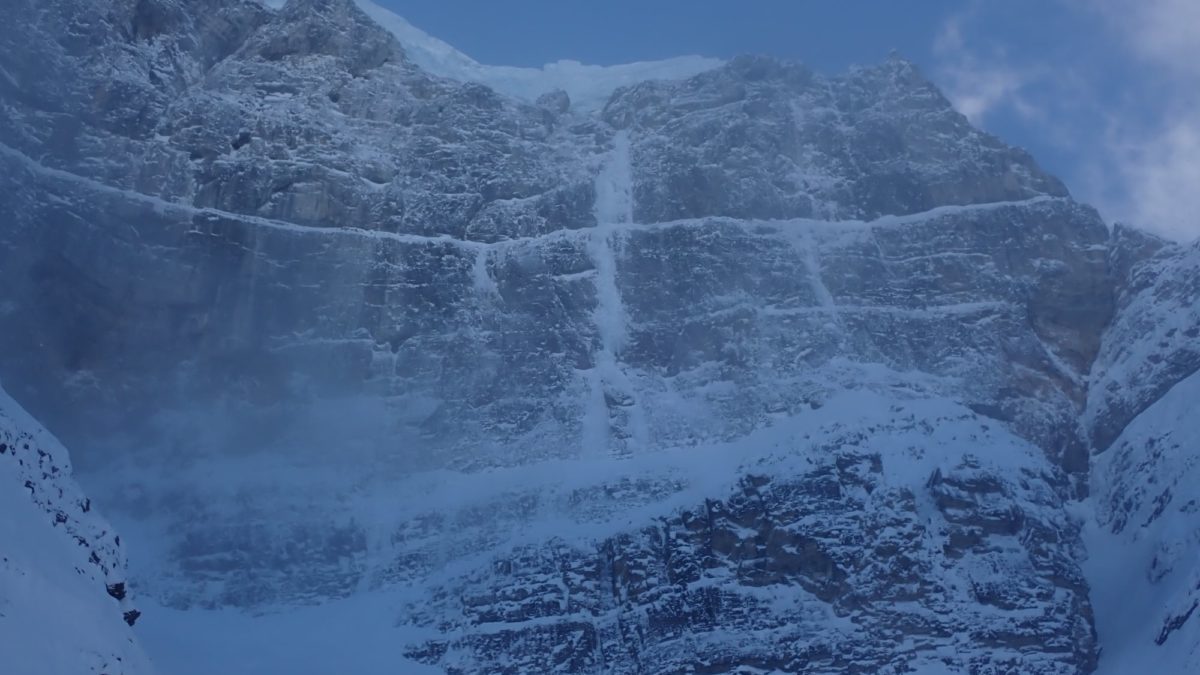Arctic Dream WI6+ in Rockies Climbed, Close Call with Serac Fall
The remote ice climb rarely forms and is one of many in the Rockies threatened by glaciers above

Arctic Dream is a tall WI6+ on an east facing wall below a hanging glacier on Mount Quadra in the Canadian Rockies. It rarely forms and has only been climbed a handful of times.
This week, it was climbed by Santi Padros and Isobel Phoebus. Padros reported his ascent on the Rockies Ice and Mixed Conditions page, saying that he’d made the approach solo earlier to check conditions. Arctic Dream is the parallel neighbour to the more popular Gimme Shelter WI6, which is not formed this year.
Padros said that they parked at 3 a.m. at Lake Louise and by 10 a.m. were climbing the first pitch. He said the third pitch was the crux at WI6+ and that by just after 4 p.m. he’d reached the top of the waterfall ice and was belaying below the serac.
The serac is massive and sometimes breaks off sending big pieces of ice down the climb. Gimme Shelter and Arctic Dream are famous for their potentially deadly seracs. In 1983, Neil Hopkins and Alex Lowe climbed the first few pitches of Gimme Shelter attempting the first ascent, but bailed because of the seracs. Hopkins said, “In the end we retreated, after several pitches of excellent, bold thin ice. This was not due to the difficulty of the climbing, but rather to my uneasiness with the seracs.”
The first ascent of Gimme Shelter was by Kevin Doyle and Tim Friesen in April 1983. Arctic Dream formed in 1992 and was climbed by Joe Josephson and Joe McKay. Like Doyle and Friesen, they also stopped below the seracs. In April 1992, Serge Angellucci and François Damilano climbed Arctic Dream through the serac to the glacier above.
Padros said that he and Phoebus did have a close call with serac fall on Arctic Dream: “A first serac fall fell over our heads, and when Isobel arrived at the belay, a second fall attacked us. The belay was in a protected place, and nothing happened to us.” He said that he didn’t believe the seracs would be active due to the conditions and because he hadn’t seen any signs of recent serac falls. He said, “I will never climb under a serac again in my life.”
Josephson added his thoughts to Padros’s report, saying, “It’s fascinating how humans can rationalize if a serac is active or not. I’ve done it plenty. This story reminds me of Guy [Lacelle] who nearly got taken out at the base after soloing the route. And Bruce and Sheila who had a similar experience on Slipstream which we’ve long considered a ‘mellow’ serac (or at least we did back in the day). These routes are just so compelling I tried so hard to find ways around these brutal realities all the time. Glad if not lucky to have survived. Thanks for sharing your story. Onward!”
Will Gadd, known for his ice and mixed climbing, also weighed in, saying, “So glad you lived, and thank you for the story and thoughts. One thing I will say here is that climbing a route like this and surviving often results in, ‘great job.’ If someone dies then it’s, ‘stupid people.’ We’ve seen this multiple times with big faces, solo climbing, climbing under seracs. The person is the same. The outcome is not the measure of the day. I have a couple of dead friends who had a lot of good years left when they died. I don’t climb under seracs with debris fields for this reason. It is not worth it to me. When someone succeeds or dies on routes like this I simply think, ‘Glad they lived.’ Santi Padrós, much respect to you for sharing your story and conclusions.”


